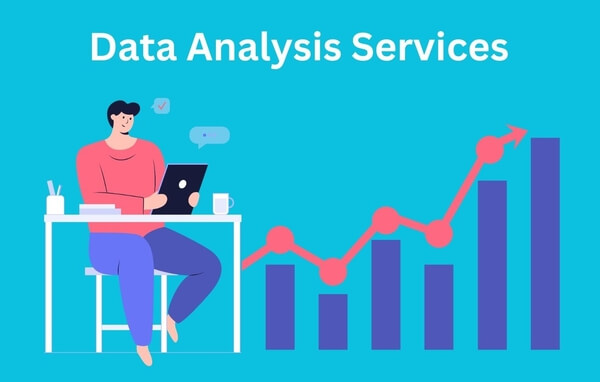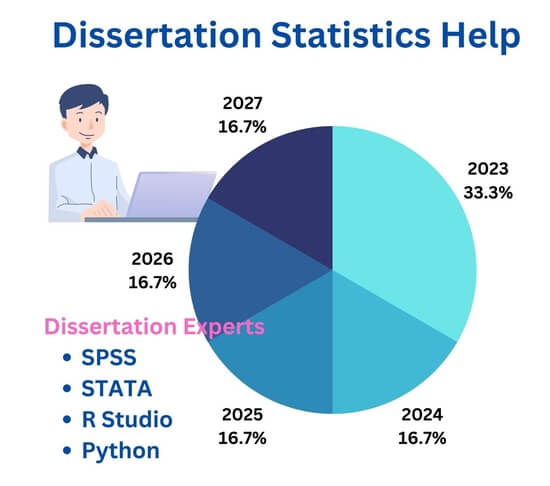Dissertation Data Analysis Services and Statistics Help
Dissertation Data Analysis and Statistics Help Offered by Experts
Dissertation data analysis is a systematic process of cleaning data, preparing it for analysis, analyzing the data using appropriate software, creating adequate visualizations, and interpreting the results of the analysis.
Data analysis requires an expert who possesses excellent analytical skills and understands your dissertation well enough to help you eliminate any weaknesses that may occur in selecting the research design, developing a data collection instrument, collecting data, formulating hypotheses, or determining the test statistics. A data analysis expert or statistician should make keen connections of all the facets involved in your dissertation and logically use the most suitable ways to interpret your data.
Our company offers dissertation statistics help with the purpose of making important deductions and suggesting recommendations that support the hypothesis presented in your dissertation. We clean your data to differentiate between pertinent and extraneous data and evaluate datasets to determine if they are adequate and relevant for the dissertation before proceeding to the actual data analysis.

Step-by-Step Process of Conducting Dissertation Statistics
Step 1: Preparation of data collected for the dissertation
Preparation of data for a dissertation involves checking to confirm that the data collected is clean, complete, and well organized. The statistician may be required to clean, format, and structure the data to make it ready for analysis.
Step 2: Data Exploration and Initial Analysis
In the initial stages of the data analysis process, the statistician conducts basic statistical analyses and applies visualization techniques to describe the data. This may involve calculating measures of central tendency such as the mean, median, and mode, and dispersion which includes range, and standard deviation. The data analyst then generates histograms, scatter plots, bar charts, and other relevant visualizations to identify patterns or trends.
Step 3: Detailed Analysis and Testing of Hypothesis
In this stage, the statistician applies appropriate statistical tests based on the research questions for the dissertation and the nature of the data. In case hypotheses were part of the methodology, then hypothesis testing is conducted. Commonly used tests in dissertation statistics help include t-tests, ANOVA, chi-square tests, correlation, and regression, among others.
Step 4: Interpretation of the Results
Interpretation involves attempting to derive meaning from the results of the analysis. In this stage the statistician evaluates the results in the context of the research questions or hypotheses. The analyst should also compare the results with existing literature and theories to provide insights and implications.
Step 5: Visualization and Reporting
To make the results easily legible by other scholars or readers, the statistician creates clear and informative charts, graphs, and tables to visually represent the results. Visual aids are used in the dissertation to enhance the reader's understanding.
Factors Statisticians Consider When Offering Dissertation Statistics Help
Students pursuing their graduate, post-graduate, or doctoral studies may opt to get online statistician to help with dissertation statistics to thoroughly and comprehensively analyze data. There are genuine online professional statisticians who provide statistical consulting services for students to successfully complete their master's thesis, dissertations, capstone projects, research papers, and other assignments.
Through dissertation statistics, doctoral students can substantiate their research methods, validate, and certify arguments, data analysis results, and reports, thus, increasing the chances of the dissertation/thesis being accepted and acknowledged by the target audience.
Our company provides the best statistics help for dissertations; assisting students with both quantitative and mixed methods studies from the research proposal development, design and methodology determination, data analysis, and presentation of findings. Those who buy the services of a statistician from our company are assured of the support of our professional experts throughout the dissertation process.
We are committed to offering comprehensive and thorough dissertation statistics help to analyze quantitative or statistical data and report valid results. In this article, we have discussed some of the factors we consider when providing dissertation statistics help.
Our statisticians possess the necessary expertise and prowess in using various software packages and techniques when analyzing data to ensure the results produced are statistically sound and presenting such results logically using tables, figures, and other visual aids.
We offer excellent statistics dissertation help founded on our exceptional understanding of mixed methods and quantitative research. The statistics tutors guide students through each step to ensure they completely understand all aspects of the data analysis process as well as the results for successful submission and defense of the dissertation/thesis.
The statistical team is qualified and experienced in the simple quantitative analysis of data and complex analytics such as structural equation modeling (SEM). Some of the factors we consider when offering statistician consultant services for a dissertation include:
1. Research aims and objectives of the dissertation
To provide the best statistical help to our clients, we ensure that, before offering consulting services, we clearly understand the aims and objectives of the research study. Once we understand what needs to be accomplished in a successfully completed dissertation, it becomes easier to choose the most appropriate approaches, methods of data analysis, and statistical tests to achieve the objectives and substantiate the results obtained.
2. The research questions, hypotheses, or problem
The type of research problem and how the research question/hypothesis is formulated influence the data analysis process and the choice of descriptive or inferential statistics. Depending on what the researcher wishes to accomplish, one may formulate relational, causal, descriptive, or comparative questions. Our statisticians strive to understand the type of research questions to be answered as well as the null and alternative hypotheses to conduct the right analyses to answer the questions and test such hypotheses statistically.
3. The research design
Based on whether the doctoral student intended to measure or directly influence variables during the research study, we evaluate how well the chosen design helped in accomplishing the purpose. Quantitative research uses experimental, quasi-experimental, descriptive, or correlational designs for data collection and analysis. We determine the study design used before conducting the analysis of data because the design determines the types of statistical tests to be used in testing the hypothesis.
4. The type and distribution of data
Data types must be defined before performing statistical analysis to determine whether to conduct parametric or non-parametric tests. Nominal, ordinal, and discrete data may be best analyzed using non-parametric tests compared to continuous data. The distribution of values in a data set determines the type of descriptive and inferential statistics to calculate for the different types of data to achieve the desired objectives.
5. Nature of the observations
The nature of observations defines whether data are paired or unpaired. In our dissertation statistical analysis services, we ensure the nature of observations is clearly defined to choose and run the most appropriate test.
6. Relevance of the collected data to research objectives of the dissertation
The initial objectives of research determine the type of data that is included in the analysis process. Having identified the objectives our clients wish to accomplish, we evaluate the types of data presented for analysis to determine those that are relevant and appropriate for accomplishing such aims and objectives.
We are committed to providing professional help with dissertation statistics to ensure focus and coherence of thought and ideas throughout the writing process. In dissertation writing, the reader must be convinced of the logic and academic reasoning following the choice and analysis of specific data types.
7. The type of quantitative or statistical analysis
Quantitative data analysis requires the application of different statistics to evaluate trends, patterns, or relationships between variables. The collected data can be organized and summarized using descriptive statistics while inferential statistics can be used to test hypotheses or estimate population parameters based on the findings obtained from a sample.
a). Descriptive statistics
Before analyzing data for a dissertation, we inspect and organize it through methods such as frequency distribution tables, charts, and plots. Through data visualization, we assess whether the collected data is skewed or normally distributed, detect outliers or missing values, and thus, determine the type of descriptive statistics that can summarize it best.
b). Inferential statistics
Inferential statistics help in testing research hypotheses of making estimation/conclusions about specific population parameters with respect to sample statistics.
-
Making an estimate
From sample statistics, population parameters can be estimated in two ways; a point estimate and an interval estimate. The type of estimate to be used depends on the aims or what the researcher wishes to infer about the targeted population. We provide a confidence interval showing the variability around the point estimate to cater for errors associated with estimation.
-
Hypothesis testing
Data from samples can be used to test hypotheses on relationships between variables in the population from which such samples were drawn. The statistical tests determine whether the null hypothesis is approved or rejected. The outputs of statistical tests tell the probability of obtaining results by chance and how much the findings differ from the null hypothesis of the test run on the data. When hired to offer statistician consultant services for a dissertation, we choose between comparison, regression, and correlation tests based on factors such as:
- Research questions.
- The research design.
- Sampling procedures.
- Characteristics of the data being analyzed.
c). The concept of parametric and non-parametric methods
Inferential statistics can be parametric or non-parametric. If the study involves comparing means, parametric inferential statistical methods are used. If the researcher aims to compare elements other than the mean, non-parametric tests are appropriate for the purpose. When offering dissertation statistics help, we ensure that the data types and their characteristics are well defined to avoid violating the assumptions of the statistical tests.
8. Sampling techniques used to select participants
In quantitative research studies, probability and non-probability sampling techniques are used to select samples from target populations. Probability sampling methods result in highly generalizable findings in theory and are effective in reducing sampling bias. We use parametric tests to draw excellent statistical inferences from data collected using probability sampling. Non-parametric tests are appropriate if the samples were obtained through non-probability sampling techniques. When offering statistics help for dissertations, our experts clearly state and justify the choice of sampling techniques used in the research.
9. The sample size
We evaluate the probability that the used sample size is an ideal representative of the population from which it was drawn to estimate:
- The level of statistical significance of the results.
- Expected effect size.
- The population standard deviation.
- The statistical power of the study.
Different statistical software tools and formulae can be used to determine the ideal sample size required for a particular study to produce accurate, valid, and reliable results.
10. Operationalization of the variables being measured
Operationalizing variables at the planning stages of the research design helps in deciding how they will be measured. While providing help with dissertation statistics, we consider the levels of measurement for the variables. The level of measurement determines whether a variable contains nominal or ordinal categorical data; interval or ratio numeric values. Considering the level of measurement for each variable is fundamental when choosing appropriate statistical methods and hypothesis tests.
11. Presentational devices for data/results
Fact that dissertations are associated with voluminous data, it is essential to present it in an orderly manner for ease of understanding and comprehension among readers and researchers. We logically use tables, figures, charts, formulae, and quotes among other techniques depending on the context and situation of the dissertation statistics to make the data visually appealing, readable, and understandable.
12. Relationship of the dissertation data analysis results with relevant literature
In our dissertation statistics consulting services, we provide comparisons between the analysis results with the findings of other researchers while noting the points of agreement or difference. Whether the findings are consistent with expectations, controversial, or marginal, we ensure the reasons and implications for such results are highlighted and described. The results should clearly and explicitly link back to the literature review chapter of the dissertation.
In addition to these factors, we edit and proofread the document and provide unlimited revisions at no extra cost. We are committed to ensuring on-time delivery for all the tasks assigned to us to allow the client enough time to review the work before the submission deadline and request edits or revisions accordingly. Our online statistician consultant services for a dissertation are available at an affordable price and are accessible on a 24/7 basis. We deliver high-quality, flawless, and plagiarism-free data analysis chapters for our clients to achieve their research objectives and score excellent grades when assessed by the target audiences.
Important Tips When Seeking Statistics Help for Dissertation
Our data analysis services ensure that your results are presented in a clear, simple, brief, and relevant format. Our statistics help for dissertation also reflects on how your methodologies contributed to obtaining your results. We achieve these goal by using clear descriptions to guide the reader through tables, graphs, and charts that present data. When presenting your results, we put emphasis on the specific outcomes that support your conclusions and present sound justifications to explain any negative results.
When you order our data analysis services for a dissertation that obtained data from people, plants, or animals, we are sure to communicate to the reader what we want them to understand from the data. We use comparisons and variations to identify trends and significant differences. Depending on the nature of data, dissertation's research design, and your set hypothesis, our data analysts select the statistical packages to use to be able to confirm if a hypothesis was confirmed, partially confirmed or unfounded.
Having the skills to correctly enter data into the right statistical package determines the kind of results you will get. Our data analysts use useful and efficient tools like SPSS to perform complicated tasks like split files when analyzing data for different subgroups. We are also proficient in coding, reverse coding, and data set filtering skills that are efficient in recognizing the type of variable available and accounting for omitted data and outliers.
In addition to helping you analyze your dissertation data, we also help you interpret the results so you can apply them in your dissertation. Our analysts provide you with a comprehensive explanation of what different figures, tables, and numbers signify and how they contribute to answering your dissertation hypothesis. We ensure that our dissertation data analysis services contribute greatly to the success of your dissertation objectives.

The Quality of Dissertation Data Analysis Services is Determined by the Expertise of the Statistician
Our data analysis process is carried out in an organized manner to ensure we do not lose any raw data. When you make your dissertation data analysis order, our analysts may make notes on mean and frequencies, inspect data subsets, and manipulate the data to accommodate different kinds of analyses.
These notes act as a record of the steps your data was taken through and the results yielded after each step. These will be important when comparing the progress of your data analysis process over the course of writing your dissertation.
Our dissertation statistics help is provided by data analysts with a machine learning background and experience in programming and data science. We, therefore, deliver high quality data analysis order within your given time-frame, and ensure your dissertation data analysis write-up is reviewed by a highly competent editor with a background in statistics.
The editor ensures that the data analysis communicates effectively the derived insights. The editor is also thorough in ascertaining that your work is properly formatted and presentable. Join our live chat to ask our customer support team more about our dissertation data analysis services or follow our order process page to access one of the best online data analysis services.

|
|







